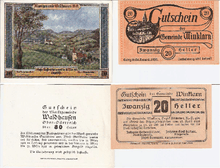Heller (money)
| 10 Slovak hellers 1942 | |
|---|---|
| | |
| Obverse | Reverse |
The Heller or ![]() Häller , originally a German coin valued at half a pfennig, took its name from the city of Hall am Kocher (today Schwäbisch Hall).
Häller , originally a German coin valued at half a pfennig, took its name from the city of Hall am Kocher (today Schwäbisch Hall).
Mints produced the coin from the beginning of the 13th century, based on a previously produced silver pfennig (Häller Pfennig, sometimes called Händelheller for its depiction of a hand on the front face), but its composition deteriorated with the mixing in copper little by little so that it was no longer considered to be a silver coin. There were red, white and black Hellers. Beginning in the Middle Ages it became a symbol of low worth, and a common German byword is "keinen (roten) Heller wert", lit.: not worth a (red) Heller, i.e. "not worth a tinker's curse".
The term Heller came into wide use as a name for coins of small value throughout many of the German states up to 1873 when, after German unification, Bismarck's administration introduced the Mark and the pfennig as coinage throughout the German Empire.
The German Heller saw a resurrection in 1904 when the government took over responsibility for the currency of German East Africa from the German East Africa Company. The Heller was introduced as 1/100 of a rupie instead of the pesa which had so far been a 1/64 of a rupie.
In Austria-Hungary, Heller was also the term used in the Austrian half of the empire for 1/100 of the Austro-Hungarian krone (the other being fillér in the Hungarian half), the currency from 1892 until after the demise (1918) of the Empire.
The term heller (Czech: haléř, Slovak: halier) was also used for a coin valued at 1/100 of a koruna (crown) in the Czech Republic (Czech koruna) and Slovakia (Slovak koruna), as well as in former Czechoslovakia (Czechoslovak koruna).
Only the currency of the Czech Republic continues to use Hellers (haléře), although they survive only as a means of calculation — the Czech National Bank removed the coins themselves from circulation in 2008 and notionally replaced them with rounding to the next koruna.

In the 1920s the "Heller" currency was expanded to greater denominations in the German territories and printed bills were produced to represent their value for trade.
See also
- Coins of the Czech koruna
- Coins of the Slovak koruna
- Czechoslovak koruna
- Øre (Subdivision of Scandinavian crowns)